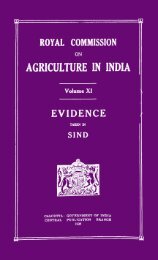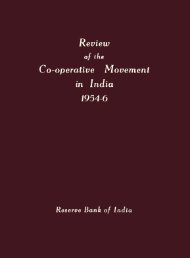All-India rural credit survey: District monograph, Osmanabad
All-India rural credit survey: District monograph, Osmanabad
All-India rural credit survey: District monograph, Osmanabad
You also want an ePaper? Increase the reach of your titles
YUMPU automatically turns print PDFs into web optimized ePapers that Google loves.
CHAPTER I<br />
GENERAL FEATURES<br />
1.1 <strong>Osmanabad</strong> is one of the districts in the Marathawada region of the former<br />
HyderabadState. The area ofthe district is approximately 3,700 square miles. The<br />
population in 1951 was about 8,07,000. <strong>Osmanabad</strong> is the headquarters of the<br />
district and in 1951 had a population of about 15,000. Latur, a taluka town, is one<br />
of the biggest marketing centres in Hyderabad State. Its population in 1951 was<br />
about 35,000 and it was the largest town in the district. The total urban population<br />
of the district was about 1,18,000, which is about 15 per cent of the total population.<br />
For administrative purposes, the district is divided into eight talukas. These<br />
may be grouped as under: (1) Bhoom, Paranda; (2) Kalam, Latur, Ansa;<br />
(3) Umerga, <strong>Osmanabad</strong>, and (4) Tuljapur.<br />
1.2 Bhoom and Paranda are the north-eastern talukas of the district lying to<br />
the west of the Balaghat hill range. The river Therna flows across the rest of the<br />
district with Kalam, Latur and Ausa to its north and Umerga, <strong>Osmanabad</strong> and<br />
Tuljapur to its south. Tuljapur is the south-western taluka and also lies mostly to<br />
the west of the Balaghat hill range.<br />
1.3 Geologically, the district falls in what is known as the trappean blackcotton<br />
soil region. The soil is highly retentive of moisture and is very fertile. There<br />
is practically no forest in the district.<br />
1.4 The district receives its rainfall mainly from the South-West monsoon<br />
but also receives a substantial amount from the North-East monsoon. To the west<br />
of the Balaghat hill range, particularly in Bhoom and Paranda talukas, the rainfall<br />
is very uncertain and the tract is liable to droughts and famine. In the remaining<br />
district, to the east of the hill range, the rainfall is more secure. Most of thct district<br />
receives about 25 to 30 inches of rain. As in other parts of the Deccan, there are<br />
two agricultural cropping seasons; the kharij, that is, the rainy season and the rabi,<br />
that is, the winter season. Khan! extends from June. to the middle of October and<br />
the rabi from the middle of October to the end of February.<br />
,<br />
1.5 As mentioned earlier, there is practically no forest in the district. Nearly<br />
93 per cent of the total area is, therefore, under cultivation. The principal food<br />
crop of the district is jowar which is grown during both the seasons; the kharij crop<br />
accounts for nearly 14 per cent and the rabi crop nearly 26 per cent of the total<br />
cropped area. There are three important commercial crops, namely, cotton, groundnut<br />
and linseed; these, respectively, cover 7, 11 and 5 per cent of the total cropped<br />
area. There is also a large area under pulses which forms nearly 20 per cent of the<br />
total cropped area .<br />
. B




